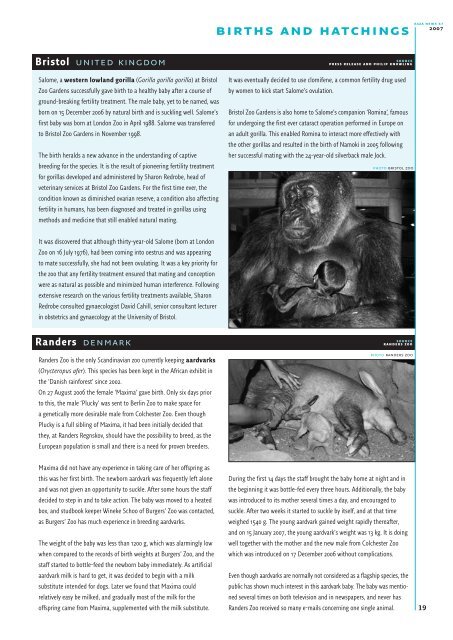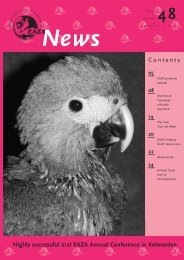EAZA News 57-12 - European Association of Zoos and Aquaria
EAZA News 57-12 - European Association of Zoos and Aquaria
EAZA News 57-12 - European Association of Zoos and Aquaria
Create successful ePaper yourself
Turn your PDF publications into a flip-book with our unique Google optimized e-Paper software.
Bristol united kingdom source<br />
press release <strong>and</strong> philip knowling<br />
Salome, a western lowl<strong>and</strong> gorilla (Gorilla gorilla gorilla) at Bristol<br />
Zoo Gardens successfully gave birth to a healthy baby after a course <strong>of</strong><br />
ground-breaking fertility treatment. The male baby, yet to be named, was<br />
born on 15 December 2006 by natural birth <strong>and</strong> is suckling well. Salome’s<br />
first baby was born at London Zoo in April 1988. Salome was transferred<br />
to Bristol Zoo Gardens in November 1998.<br />
The birth heralds a new advance in the underst<strong>and</strong>ing <strong>of</strong> captive<br />
breeding for the species. It is the result <strong>of</strong> pioneering fertility treatment<br />
for gorillas developed <strong>and</strong> administered by Sharon Redrobe, head <strong>of</strong><br />
veterinary services at Bristol Zoo Gardens. For the first time ever, the<br />
condition known as diminished ovarian reserve, a condition also affecting<br />
fertility in humans, has been diagnosed <strong>and</strong> treated in gorillas using<br />
methods <strong>and</strong> medicine that still enabled natural mating.<br />
It was discovered that although thirty-year-old Salome (born at London<br />
Zoo on 16 July 1976), had been coming into oestrus <strong>and</strong> was appearing<br />
to mate successfully, she had not been ovulating. It was a key priority for<br />
the zoo that any fertility treatment ensured that mating <strong>and</strong> conception<br />
were as natural as possible <strong>and</strong> minimized human interference. Following<br />
extensive research on the various fertility treatments available, Sharon<br />
Redrobe consulted gynaecologist David Cahill, senior consultant lecturer<br />
in obstetrics <strong>and</strong> gynaecology at the University <strong>of</strong> Bristol.<br />
It was eventually decided to use clomifene, a common fertility drug used<br />
by women to kick start Salome’s ovulation.<br />
Bristol Zoo Gardens is also home to Salome’s companion ‘Romina’, famous<br />
for undergoing the first ever cataract operation performed in Europe on<br />
an adult gorilla. This enabled Romina to interact more effectively with<br />
the other gorillas <strong>and</strong> resulted in the birth <strong>of</strong> Namoki in 2005 following<br />
her successful mating with the 24-year-old silverback male Jock.<br />
photo bristol zoo<br />
R<strong>and</strong>ers denmark source<br />
r<strong>and</strong>ers zoo<br />
R<strong>and</strong>ers Zoo is the only Sc<strong>and</strong>inavian zoo currently keeping aardvarks<br />
(Orycteropus afer). This species has been kept in the African exhibit in<br />
the ‘Danish rainforest’ since 2002.<br />
On 27 August 2006 the female ‘Maxima’ gave birth. Only six days prior<br />
to this, the male ‘Plucky’ was sent to Berlin Zoo to make space for<br />
a genetically more desirable male from Colchester Zoo. Even though<br />
Plucky is a full sibling <strong>of</strong> Maxima, it had been initially decided that<br />
they, at R<strong>and</strong>ers Regnskov, should have the possibility to breed, as the<br />
<strong>European</strong> population is small <strong>and</strong> there is a need for proven breeders.<br />
Maxima did not have any experience in taking care <strong>of</strong> her <strong>of</strong>fspring as<br />
this was her first birth. The newborn aardvark was frequently left alone<br />
<strong>and</strong> was not given an opportunity to suckle. After some hours the staff<br />
decided to step in <strong>and</strong> to take action. The baby was moved to a heated<br />
box, <strong>and</strong> studbook keeper Wineke Schoo <strong>of</strong> Burgers’ Zoo was contacted,<br />
as Burgers’ Zoo has much experience in breeding aardvarks.<br />
The weight <strong>of</strong> the baby was less than <strong>12</strong>00 g, which was alarmingly low<br />
when compared to the records <strong>of</strong> birth weights at Burgers’ Zoo, <strong>and</strong> the<br />
staff started to bottle-feed the newborn baby immediately. As artificial<br />
aardvark milk is hard to get, it was decided to begin with a milk<br />
substitute intended for dogs. Later we found that Maxima could<br />
relatively easy be milked, <strong>and</strong> gradually most <strong>of</strong> the milk for the<br />
<strong>of</strong>fspring came from Maxima, supplemented with the milk substitute.<br />
births <strong>and</strong> hatchings<br />
photo r<strong>and</strong>ers zoo<br />
During the first 14 days the staff brought the baby home at night <strong>and</strong> in<br />
the beginning it was bottle-fed every three hours. Additionally, the baby<br />
was introduced to its mother several times a day, <strong>and</strong> encouraged to<br />
suckle. After two weeks it started to suckle by itself, <strong>and</strong> at that time<br />
weighed 1540 g. The young aardvark gained weight rapidly thereafter,<br />
<strong>and</strong> on 15 January 2007, the young aardvark’s weight was 13 kg. It is doing<br />
well together with the mother <strong>and</strong> the new male from Colchester Zoo<br />
which was introduced on 17 December 2006 without complications.<br />
Even though aardvarks are normally not considered as a flagship species, the<br />
public has shown much interest in this aardvark baby. The baby was mentioned<br />
several times on both television <strong>and</strong> in newspapers, <strong>and</strong> never has<br />
R<strong>and</strong>ers Zoo received so many e-mails concerning one single animal.<br />
eaza news <strong>57</strong><br />
2007<br />
19

















